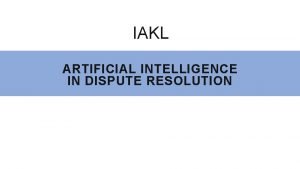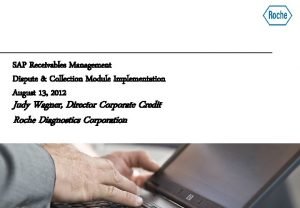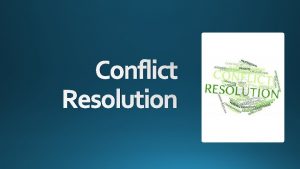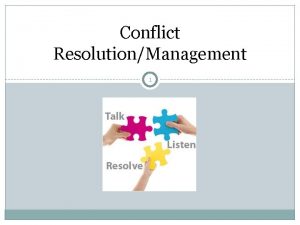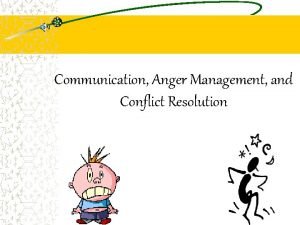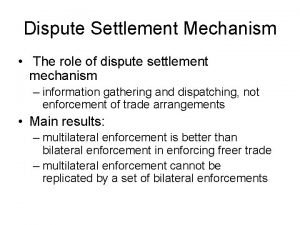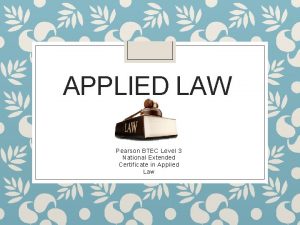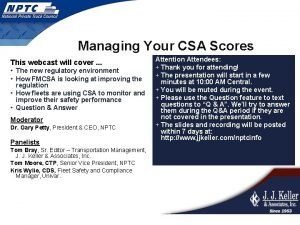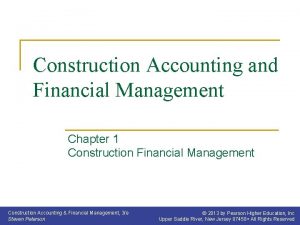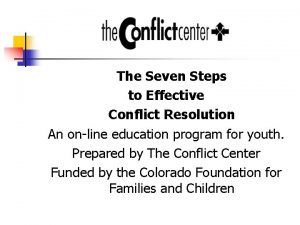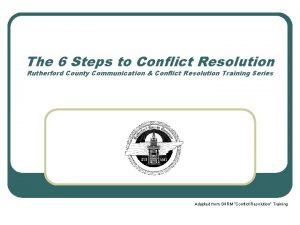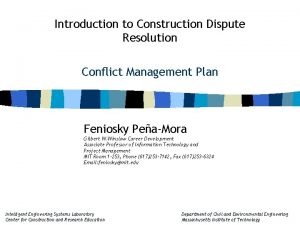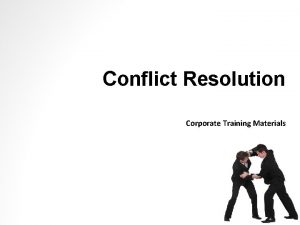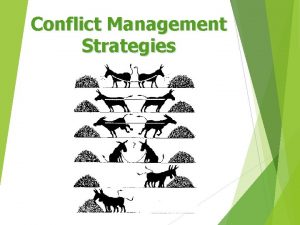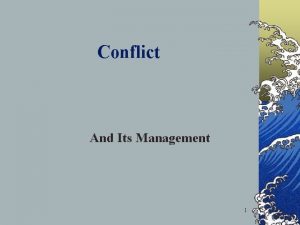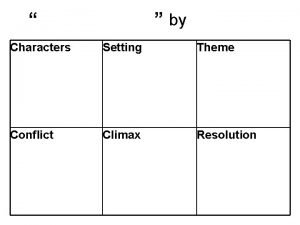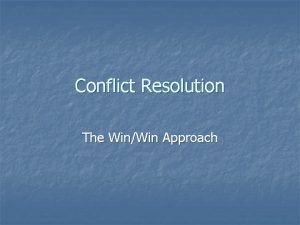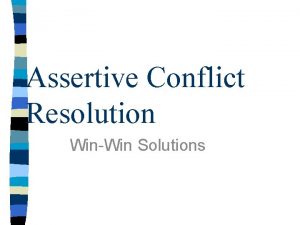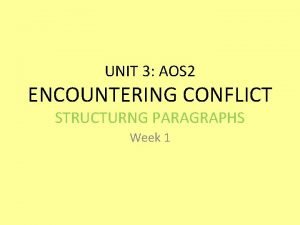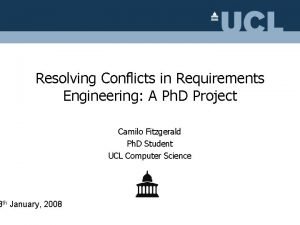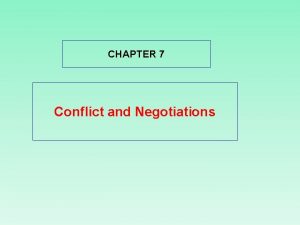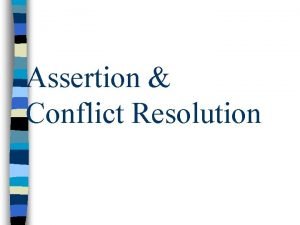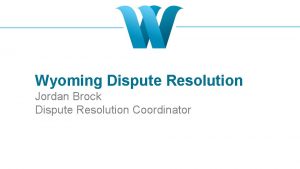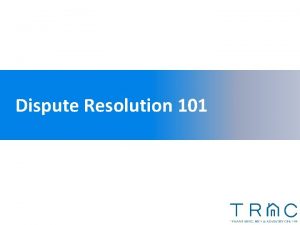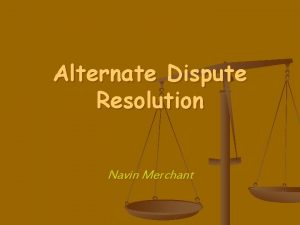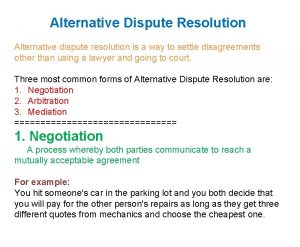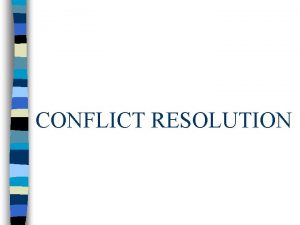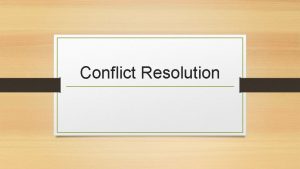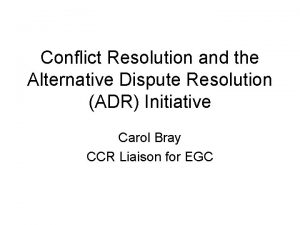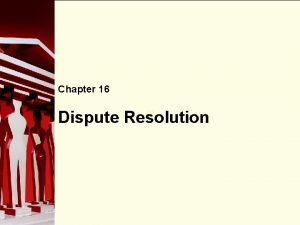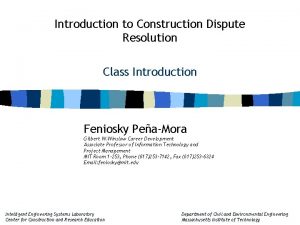Introduction to Construction Dispute Resolution Conflict Management Plan
















































![References n [Pena-Mora et al. , 2001] : Pena-Mora, Feniosky and Tamaki, Tadatsugu (2001). References n [Pena-Mora et al. , 2001] : Pena-Mora, Feniosky and Tamaki, Tadatsugu (2001).](https://slidetodoc.com/presentation_image_h2/54d43348afad4d58476e155e7b56c0f1/image-49.jpg)
- Slides: 49

Introduction to Construction Dispute Resolution Conflict Management Plan Feniosky Peña-Mora Gilbert W. Winslow Career Development Associate Professor of Information Technology and Project Management MIT Room 1 -253, Phone (617)253 -7142, Fax (617)253 -6324 Email: feniosky@mit. edu Intelligent Engineering Systems Laboratory Center for Construction and Research Education Department of Civil and Environmental Engineering Massachusetts Institute of Technology

Definitions n WHAT • Assessing Susceptibility of Each Project to Conflicts and Gravity of the Conflicts • Developing Cost Effective Ways for Conflict Avoidance and Dispute Control • Presenting Complete, Unbiased and Unanimous Plans n WHO • Owner, Owner’s Representatives, Designers, Lawyers, Contractors n WHY • Responsibility Allocation and Reduction of Court Proceedings n HOW • Identify the Potential Sources of Conflict • Analyze the Severity and the Impacts of Conflicts • Match the Conflict with a Corresponding DART 2 • Draft Plan, Review and Revise it Continuously Introduction to Construction Dispute Resolution Chapter 10: Conflict Management Plan © Peña-Mora, et. al. 2002

Case Study : Brock’s Plans n Real Estate Development (Family Business): Mainly Department and Retail Stores Projects (US$1 to US$10 Million) n No Previous Experience in Hotel Development Business n US$20, 000 Million Hotel Development Project n Funding Provided by Developer and Banks n Excellent Reputation and Willingness of Banks to Finance n Negotiated Cost Basis , Plus Fee Equal to 3. 5% of Total Construction Costs n Completion of 90% of Design at Contract Award 3 Introduction to Construction Dispute Resolution Chapter 10: Conflict Management Plan © Peña-Mora, et. al. 2002

Case Study : Kelly’s Plans n Senior Procurement Officer for the State Aviation Administration n US$1. 5 Billion Fast-Tracked Capital Improvement Program : 19 Contracts (US$20 Million - US$ 400 Million) n Interdependent Schedules and Overlapping of Design and Construction Phases n Fixed Price, Design-Bid-Build Projects, Operation and Maintenance 4 Introduction to Construction Dispute Resolution Chapter 10: Conflict Management Plan © Peña-Mora, et. al. 2002

Important Issues n How Should Kelly and Brock Go About Planning to Identify, Avoid, Monitor and Control Any Potential Conflict? n How Should Brock’s Approach Differ From Kelly’s Approach? n Could These Both Use the Same Methodology? n Are There Restrictions on What Dart Each of Them Could Use? 5 Introduction to Construction Dispute Resolution Chapter 10: Conflict Management Plan © Peña-Mora, et. al. 2002

Outline Ø Conflict Management Process n Identifying Possible Conflicts • Effect of Delivery System on Identifying Conflicts n Analyzing Identified Conflicts • Probability of Occurrence • Impact of Conflict • Combined Conflict Exposure n Designing the Management Plan • Prioritizing and DART Implementation • Identification : Who Is Responsible? • Cost/Benefit Issues • Contingency Plan • Computer Applications n 6 Importance of Review • Conflict Resolution Indexes Introduction to Construction Dispute Resolution Chapter 10: Conflict Management Plan © Peña-Mora, et. al. 2002

Conflict Management Process n Objective • Look at Each Project Individually • Assess How Much Conflict You Will Encounter • Assess How Severe Is the Conflict • Present Cost Effective Ways to Avoid Conflicts • Mitigate Impact of Conflict • Resolve Disputes 7 Introduction to Construction Dispute Resolution Chapter 10: Conflict Management Plan © Peña-Mora, et. al. 2002

Common Steps Conflict Identification Conflict Analysis Design and Implement Conflict Management Monitor and Review Plan Peña-Mora, et. al, 2002 8 Introduction to Construction Dispute Resolution Chapter 10: Conflict Management Plan © Peña-Mora, et. al. 2002

Conflict Space n The Conflict Management Plan Should be Able to Handle at the Same Time • The Cumulative Effect of Conflicts Throughout the Project Life Cycle • The Different Conflicts at Different Stages of the Dispute Resolution Ladder at a Specific Time 9 Introduction to Construction Dispute Resolution Chapter 10: Conflict Management Plan © Peña-Mora, et. al. 2002

Conflict Space Degree of Conflict litigation Dispute Resolution Ladder arbitration mediation Standing neutral negotiation Cumulative Effect of Conflict Project Life Cycle Peña-Mora, et. al, 2002 10 Introduction to Construction Dispute Resolution Chapter 10: Conflict Management Plan © Peña-Mora, et. al. 2002

Outline ü Conflict Management Process Ø Identifying Possible Conflicts • Effect of Delivery System on Identifying Conflicts n Analyzing Identified Conflicts • Probability of Occurrence • Impact of Conflict • Combined Conflict Exposure n Designing the Management Plan • Prioritizing and DART Implementation • Identification : Who Is Responsible? • Cost/Benefit Issues • Contingency Plan • Computer Applications n 11 Importance of Review • Conflict Resolution Indexes Introduction to Construction Dispute Resolution Chapter 10: Conflict Management Plan © Peña-Mora, et. al. 2002

Identifying Possible Conflicts n Review of the Common Sources of Conflict 12 Peña-Mora, et. al, 2002 Introduction to Construction Dispute Resolution Chapter 10: Conflict Management Plan © Peña-Mora, et. al. 2002

Outline ü Conflict Management Process ü Identifying Possible Conflicts Ø Effect of Delivery System on Identifying Conflicts n Analyzing Identified Conflicts • Probability of Occurrence • Impact of Conflict • Combined Conflict Exposure n Designing the Management Plan • Prioritizing and DART Implementation • Identification : Who Is Responsible? • Cost/Benefit Issues • Contingency Plan • Computer Applications n 13 Importance of Review • Conflict Resolution Indexes Introduction to Construction Dispute Resolution Chapter 10: Conflict Management Plan © Peña-Mora, et. al. 2002

Effect of Delivery System on Identifying Conflicts n Identify the Potential Conflicts that Need to be Avoided n Select a Delivery System that Minimizes Such Conflicts 14 Introduction to Construction Dispute Resolution Chapter 10: Conflict Management Plan © Peña-Mora, et. al. 2002

Example: Selection of a Delivery System n Stephenson (1996) • Establish a Detailed List of Potential Conflicts Based on Historical Data or Personal Experience • Identify the Relationships Between the Participants (For Ex, Owner-CM, Owner-Designer) • For Each Delivery System, Match the Potential Conflict with the Concerned Relationships and Give it a Specific Number of Points • Add up the Total Number of Points for Each Delivery System 15 and Choose the Best Approach Introduction to Construction Dispute Resolution Chapter 10: Conflict Management Plan © Peña-Mora, et. al. 2002

Outline ü Conflict Management Process ü Identifying Possible Conflicts ü Effect of Delivery System on Identifying Conflicts Ø Analyzing Identified Conflicts • Probability of Occurrence • Impact of Conflict • Combined Conflict Exposure n Designing the Management Plan • Prioritizing and DART Implementation • Identification : Who Is Responsible? • Cost/Benefit Issues • Contingency Plan • Computer Applications n 16 Importance of Review • Conflict Resolution Indexes Introduction to Construction Dispute Resolution Chapter 10: Conflict Management Plan © Peña-Mora, et. al. 2002

Analyzing Identified Conflicts n Probability of Occurrence of Conflicts n Impact of Potential Conflicts on Project 17 Introduction to Construction Dispute Resolution Chapter 10: Conflict Management Plan © Peña-Mora, et. al. 2002

Examples n Probability of Occurrence of Conflicts • Assume that the Identified Sources of Conflict Are Misunderstandings, Unrealistic Expectations and Poor Communication, Compare the Two Cases: – Case 1 : Owner and Contractor With Previous Experience Together, in the Same Geographic Region – Case 2 : Owner Venturing into a Neighboring Country and Working with an Unfamiliar Contractor n Impact of Potential Conflicts on Project • Two Similar Projects With Introduction of Design Change Halfway Through Construction – Project 1 : Design-Bid-Build Approach – Project 2 : Design-Build Approach 18 Introduction to Construction Dispute Resolution Chapter 10: Conflict Management Plan © Peña-Mora, et. al. 2002

Outline ü Conflict Management Process ü Identifying Possible Conflicts ü Effect of Delivery System on Identifying Conflicts ü Analyzing Identified Conflicts Ø Probability of Occurrence • Impact of Conflict • Combined Conflict Exposure n Designing the Management Plan • Prioritizing and DART Implementation • Identification : Who Is Responsible? • Cost/Benefit Issues • Contingency Plan • Computer Applications n 19 Importance of Review • Conflict Resolution Indexes Introduction to Construction Dispute Resolution Chapter 10: Conflict Management Plan © Peña-Mora, et. al. 2002

Probability of Occurrence n Organizational Issues n Uncertainty 20 Introduction to Construction Dispute Resolution Chapter 10: Conflict Management Plan © Peña-Mora, et. al. 2002

Organizational Issues n Structure Conflict: Example: Contract Terms • Case 1 : Fair and Reasonable Allocation of Risk Low Probability • Case 2: Unfair, Unreasonable Allocation of Risk High Probability n Process Conflict: Example: Performance and Quality • Case 1: Cost-Plus, Quality Driven Projects, Inspection Staff Low Probability • Case 2: Competitive Bids Award to Lowest Bidder, Bad Reputation High Probability n People Conflict: Example: Management • Case 1 : Long Distinguish Solid Managers Low Probability 21 • Case 2 : Inexperienced Participants High Probability Introduction to Construction Dispute Resolution Chapter 10: Conflict Management Plan © Peña-Mora, et. al. 2002

Uncertainty n External Uncertainty : Example: Political Risks • Case 1 : Stable, Well Developed Governments Low Probability • Case 2 : Afghanistan During the Soviet Invasion Throughout the 1980’s High Probability n Internal Uncertainty : Example : Unforeseen Site Conditions • Case 1 : Open, Above Ground Projects with Adequate Investigation Low Probability • Case 2 : Lack of Subsurface Investigation for All Participants High Probability 22 Introduction to Construction Dispute Resolution Chapter 10: Conflict Management Plan © Peña-Mora, et. al. 2002

Outline ü Conflict Management Process ü Identifying Possible Conflicts ü Effect of Delivery System on Identifying Conflicts ü Analyzing Identified Conflicts ü Probability of Occurrence Ø Impact of Conflict • Combined Conflict Exposure n Designing the Management Plan • Prioritizing and DART Implementation • Identification : Who Is Responsible? • Cost/Benefit Issues • Contingency Plan • Computer Applications n 23 Importance of Review • Conflict Resolution Indexes Introduction to Construction Dispute Resolution Chapter 10: Conflict Management Plan © Peña-Mora, et. al. 2002

Impact of Conflict n Quantification Tools • Historical Data • Experience and Knowledge n Example • Weather: Low Impact in Construction ‘ Friendly’ Environment and High Impact in Areas Prone to Natural Disasters 24 Introduction to Construction Dispute Resolution Chapter 10: Conflict Management Plan © Peña-Mora, et. al. 2002

Outline ü Conflict Management Process ü Identifying Possible Conflicts ü Effect of Delivery System on Identifying Conflicts ü Analyzing Identified Conflicts ü Probability of Occurrence ü Impact of Conflict Ø Combined Conflict Exposure n Designing the Management Plan • Prioritizing and DART Implementation • Identification : Who Is Responsible? • Cost/Benefit Issues • Contingency Plan • Computer Applications n 25 Importance of Review • Conflict Resolution Indexes Introduction to Construction Dispute Resolution Chapter 10: Conflict Management Plan © Peña-Mora, et. al. 2002

Combined Conflict Exposure n Step 1 : Calculate Conflict Exposure=P(C)x L(C) Where: • P(C) Is the Probability of Occurrence • L(C) Is the Impact of Occurrence n Step 2: Group Conflicts Into Priority Levels: • Group A : 10 -20% of the Top Conflicts Accounting for Roughly 60% or More of the Total Potential Impact • Group B : Conflicts not in A or B • Group C : Large % of the Bottom Conflicts Accounting for 10% or Less of the Total Potential Impact 26 Introduction to Construction Dispute Resolution Chapter 10: Conflict Management Plan © Peña-Mora, et. al. 2002

Example: $200 M Project Risk Exposure: P(c) x L(c) Large Problem P(c)=0. 10 L(C)=$25 M Project (no mitigation strategy) Medium Problem P(c)=0. 20 L(C)=$5 M Small Problem P(c)=0. 70 L(C)=$1 M 2. 5 M 1 M 10. 5 M 0. 7 M 27 Introduction to Construction Dispute Resolution Chapter 10: Conflict Management Plan © Peña-Mora, et. al. 2002

Outline ü Conflict Management Process ü Identifying Possible Conflicts ü Effect of Delivery System on Identifying Conflicts ü Analyzing Identified Conflicts ü Probability of Occurrence ü Impact of Conflict ü Combined Conflict Exposure Ø Designing the Management Plan • Prioritizing and DART Implementation • Identification : Who Is Responsible? • Cost/Benefit Issues • Contingency Plan • Computer Applications n 28 Importance of Review • Conflict Resolution Indexes Introduction to Construction Dispute Resolution Chapter 10: Conflict Management Plan © Peña-Mora, et. al. 2002

Designing the Management Plan n Prioritize The Sources Of Conflict. n Implement Dart To Avoid/prevent Conflict Using Techniques In Stage 1 And Partnering. n Implement Dart To Resolve Conflict, Using Techniques In Stages 2 Through 5. n Identify Each Participant’s Role. n Perform A Cost/benefit Analysis Of The Conflict Management Plan. n Develop A Contingency Plan. n Review With All Participants And Update As Necessary. 29 Introduction to Construction Dispute Resolution Chapter 10: Conflict Management Plan © Peña-Mora, et. al. 2002

Outline ü Conflict Management Process ü Identifying Possible Conflicts ü Effect of Delivery System on Identifying Conflicts ü Analyzing Identified Conflicts ü Probability of Occurrence ü Impact of Conflict ü Combined Conflict Exposure ü Designing the Management Plan Ø Prioritizing and DART Implementation • Identification : Who Is Responsible? • Cost/Benefit Issues • Contingency Plan • Computer Applications n 30 Importance of Review • Conflict Resolution Indexes Introduction to Construction Dispute Resolution Chapter 10: Conflict Management Plan © Peña-Mora, et. al. 2002

Prioritizing and DART Implementation 31 Introduction to Construction Dispute Resolution Chapter 10: Conflict Management Plan © Peña-Mora, et. al. 2002

Outline ü Conflict Management Process ü Identifying Possible Conflicts ü Effect of Delivery System on Identifying Conflicts ü Analyzing Identified Conflicts ü Probability of Occurrence ü Impact of Conflict ü Combined Conflict Exposure ü Designing the Management Plan ü Prioritizing and DART Implementation Ø Identification : Who Is Responsible? • Cost/Benefit Issues • Contingency Plan • Computer Applications n 32 Importance of Review • Conflict Resolution Indexes Introduction to Construction Dispute Resolution Chapter 10: Conflict Management Plan © Peña-Mora, et. al. 2002

Identification: Who Is Responsible? n Agreement on Allocating the Responsibility for Conflicts • Through Contract Clauses • In Conflict Management Plan n Eliminating Confusion Between Clauses and Management Plan 33 Introduction to Construction Dispute Resolution Chapter 10: Conflict Management Plan © Peña-Mora, et. al. 2002

Outline ü Conflict Management Process ü Identifying Possible Conflicts ü Effect of Delivery System on Identifying Conflicts ü Analyzing Identified Conflicts ü Probability of Occurrence ü Impact of Conflict ü Combined Conflict Exposure ü Designing the Management Plan ü Prioritizing and DART Implementation ü Identification : Who Is Responsible? Ø Cost/Benefit Issues • Contingency Plan • Computer Applications n 34 Importance of Review • Conflict Resolution Indexes Introduction to Construction Dispute Resolution Chapter 10: Conflict Management Plan © Peña-Mora, et. al. 2002

Cost/Benefit Issues Risk Exposure P(c) x L(c) P(c) = 0. 10 Large Problem L(c) = $ 25 M Yes 0. 1 x 25 = 2. 5 M P(c) = 0. 20 Medium Problem L(c) = $ 5 M 0. 2 x 5 = 1 M P(c) = 0. 70 Small Problem L(c) = $ 1 M 0. 7 x 1 = 7 M P(c) = 0. 40 Large Problem L(c) = $ 25 M 0. 4 x 25 = 10 M + 2. 5 + 1 + 7 = 10. 5 M Partnering No P(c) = 0. 50 Medium Problem L(c) = $ 5 M 0. 5 x 5 = 2. 5 M P(c) = 0. 20 Minor Problems L(c) = $ 1 M 0. 1 x 1 = 1 M + 10 + 2. 5 + 1 = 13. 5 M 35 Introduction to Construction Dispute Resolution Chapter 10: Conflict Management Plan © Peña-Mora, et. al. 2002

Outline ü Conflict Management Process ü Identifying Possible Conflicts ü Effect of Delivery System on Identifying Conflicts ü Analyzing Identified Conflicts ü Probability of Occurrence ü Impact of Conflict ü Combined Conflict Exposure ü Designing the Management Plan ü Prioritizing and DART Implementation ü Identification : Who Is Responsible? ü Cost/Benefit Issues Ø Contingency Plan • Computer Applications n 36 Importance of Review • Conflict Resolution Indexes Introduction to Construction Dispute Resolution Chapter 10: Conflict Management Plan © Peña-Mora, et. al. 2002

Contingency Plan n List of Options of Both Parties n Strengths and Weaknesses of Conflict Management Plan n Identification of Areas Where No Conflict Mitigation Plan is Implemented n Backup in Case of the Unpredictable (Mainly Litigation) : “What If? ” Process 37 Introduction to Construction Dispute Resolution Chapter 10: Conflict Management Plan © Peña-Mora, et. al. 2002

Outline ü Conflict Management Process ü Identifying Possible Conflicts ü Effect of Delivery System on Identifying Conflicts ü Analyzing Identified Conflicts ü Probability of Occurrence ü Impact of Conflict ü Combined Conflict Exposure ü Designing the Management Plan ü Prioritizing and DART Implementation ü Identification : Who Is Responsible? ü Cost/Benefit Issues ü Contingency Plan Ø Computer Applications n 38 Importance of Review • Conflict Resolution Indexes Introduction to Construction Dispute Resolution Chapter 10: Conflict Management Plan © Peña-Mora, et. al. 2002

Computer Applications 39 Peña-Mora, et. al, 2002 Introduction to Construction Dispute Resolution Chapter 10: Conflict Management Plan © Peña-Mora, et. al. 2002

Outline ü Conflict Management Process ü Identifying Possible Conflicts ü Effect of Delivery System on Identifying Conflicts ü Analyzing Identified Conflicts ü Probability of Occurrence ü Impact of Conflict ü Combined Conflict Exposure ü Designing the Management Plan ü Prioritizing and DART Implementation ü Identification : Who Is Responsible? ü Cost/Benefit Issues ü Contingency Plan ü Computer Applications Ø 40 Importance of Review • Conflict Resolution Indexes Introduction to Construction Dispute Resolution Chapter 10: Conflict Management Plan © Peña-Mora, et. al. 2002

Importance of Review n Importance of Review and Acceptance of the Plan by All the Parties n Objective of Review at Various Stages of Project Life Cycle : Inform All the Parties and Make Them Partners in the Process 41 Introduction to Construction Dispute Resolution Chapter 10: Conflict Management Plan © Peña-Mora, et. al. 2002

Outline ü Conflict Management Process ü Identifying Possible Conflicts ü Effect of Delivery System on Identifying Conflicts ü Analyzing Identified Conflicts ü Probability of Occurrence ü Impact of Conflict ü Combined Conflict Exposure ü Designing the Management Plan ü Prioritizing and DART Implementation ü Identification : Who Is Responsible? ü Cost/Benefit Issues ü Contingency Plan ü Computer Applications ü 42 Importance of Review Ø Conflict Resolution Indexes Introduction to Construction Dispute Resolution Chapter 10: Conflict Management Plan © Peña-Mora, et. al. 2002

Conflict Resolution Indexes Peña-Mora et al. , 2001 43 Introduction to Construction Dispute Resolution Chapter 10: Conflict Management Plan © Peña-Mora, et. al. 2002

Review Process Peña-Mora et al. , 2001 44 Introduction to Construction Dispute Resolution Chapter 10: Conflict Management Plan © Peña-Mora, et. al. 2002

Outline ü Conflict Management Process ü Identifying Possible Conflicts ü Effect of Delivery System on Identifying Conflicts ü Analyzing Identified Conflicts ü Probability of Occurrence ü Impact of Conflict ü Combined Conflict Exposure ü Designing the Management Plan ü Prioritizing and DART Implementation ü Identification : Who Is Responsible? ü Cost/Benefit Issues ü Contingency Plan ü Computer Applications ü 45 Importance of Review ü Conflict Resolution Indexes Introduction to Construction Dispute Resolution Chapter 10: Conflict Management Plan © Peña-Mora, et. al. 2002

Kelly’s Plan 46 Introduction to Construction Dispute Resolution Chapter 10: Conflict Management Plan © Peña-Mora, et. al. 2002

Brock’s Plan 47 Introduction to Construction Dispute Resolution Chapter 10: Conflict Management Plan © Peña-Mora, et. al. 2002

Summary n Conflict Management Plan • Vital Step in Construction Projects • Often Overlooked • Conceived in the Planning Phase and Reviewed Throughout Project Life Cycle • Identifying Conflicts and Analyzing Their Impacts • Prioritizing Conflicts • Application of Dispute Avoidance Techniques • Design of a Resolution Procedure • Allocation of Risks Between Participants 48 Introduction to Construction Dispute Resolution Chapter 10: Conflict Management Plan © Peña-Mora, et. al. 2002
![References n PenaMora et al 2001 PenaMora Feniosky and Tamaki Tadatsugu 2001 References n [Pena-Mora et al. , 2001] : Pena-Mora, Feniosky and Tamaki, Tadatsugu (2001).](https://slidetodoc.com/presentation_image_h2/54d43348afad4d58476e155e7b56c0f1/image-49.jpg)
References n [Pena-Mora et al. , 2001] : Pena-Mora, Feniosky and Tamaki, Tadatsugu (2001). Effect of Delivery Systems on Collaborative Negotiations for Large-Scale Infrastructure. ASCE Journal of Management in Engineering, Vol. 17 (2), April 2001. n [Peña-Mora et al, 2002] : Peña-Mora, F. , Sosa, C. , and Mc. Cone, S. Introduction to Construction Dispute Resolution. Prentice Hall, New Jersey, 2002 n [Stephenson, 1996] : Stephenson, R. (1996). Project Partnering for the Design and Construction Industry. Wiley. New York. 1996. Pfleeger, Shari Lawrence. Software engineering: Theory and Practice. Upper Saddle River, NJ. Prentice Hall. 2001. Jalote, P. An integrated approach to software engineering. New York. Springer. 1997. Braude, Eric J. Software engineering: An object-oriented perspective. New York. Wiley. 2001. 49 Introduction to Construction Dispute Resolution Chapter 10: Conflict Management Plan © Peña-Mora, et. al. 2002
 Msc construction law
Msc construction law What is conflict and conflict resolution?
What is conflict and conflict resolution? Dispute management ai
Dispute management ai Receivables management sap
Receivables management sap Credit management in o2c
Credit management in o2c Watch mastering conflict management and resolution at work
Watch mastering conflict management and resolution at work Watch mastering conflict management and resolution at work
Watch mastering conflict management and resolution at work Mastering conflict management and resolution at work
Mastering conflict management and resolution at work Better communication when angry
Better communication when angry Anger management and conflict resolution
Anger management and conflict resolution High resolution low resolution
High resolution low resolution Objectives of industrial dispute act 1947
Objectives of industrial dispute act 1947 Krishna godavari dispute
Krishna godavari dispute Objectives of industrial dispute act 1947
Objectives of industrial dispute act 1947 Wto dispute settlement mechanism
Wto dispute settlement mechanism Dispute settlement mechanism meaning
Dispute settlement mechanism meaning Right dispute
Right dispute Objectives of industrial dispute act 1947
Objectives of industrial dispute act 1947 Maine canada border dispute
Maine canada border dispute Pearson applied law past papers
Pearson applied law past papers Antecedent boundary
Antecedent boundary Financial education services testimonials
Financial education services testimonials Consequent boundary definition ap human geography
Consequent boundary definition ap human geography How to dispute csa points
How to dispute csa points Delay and dispute mitigation
Delay and dispute mitigation Introduction to construction financial management
Introduction to construction financial management Cudsa communication model
Cudsa communication model Work immersion portfolio
Work immersion portfolio How many rectangle
How many rectangle 6 steps conflict resolution
6 steps conflict resolution Conflict management customer service
Conflict management customer service Accountability in conflict resolution
Accountability in conflict resolution Conflict resolution outline
Conflict resolution outline Conflict resolution skills
Conflict resolution skills Conflict resolution training materials
Conflict resolution training materials Thomas-kilmann conflict mode exercise
Thomas-kilmann conflict mode exercise Scope of conflict resolution
Scope of conflict resolution Steps in the mediation process
Steps in the mediation process Center for african peace and conflict resolution
Center for african peace and conflict resolution What conflict is introduced in this excerpt justin lebo
What conflict is introduced in this excerpt justin lebo The necklace setting time
The necklace setting time Staben conflict resolution
Staben conflict resolution Conflict resolution win win
Conflict resolution win win Write these down
Write these down Topic about peace
Topic about peace Conflict resolution paragraphs
Conflict resolution paragraphs Setting of the alchemist
Setting of the alchemist Conflict resolution in software engineering
Conflict resolution in software engineering Superordinate goals conflict resolution technique
Superordinate goals conflict resolution technique Passive conflict resolution
Passive conflict resolution


